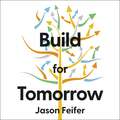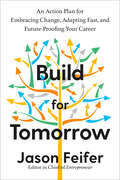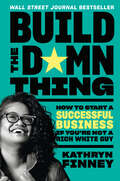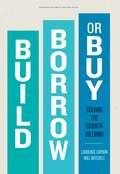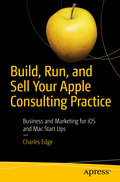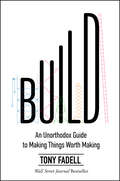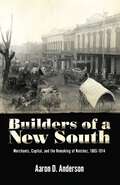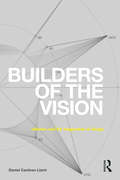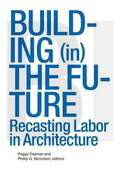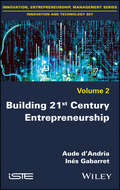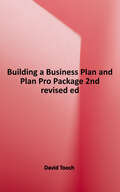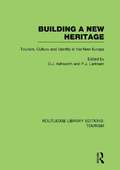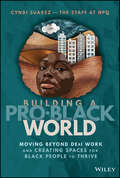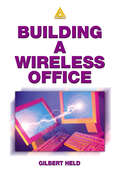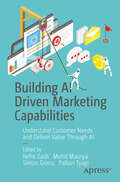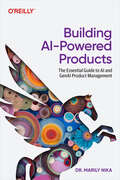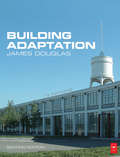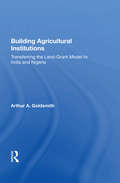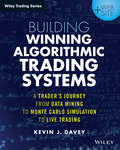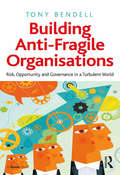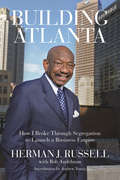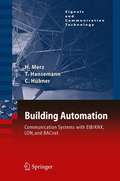- Table View
- List View
Build for Tomorrow: An Action Plan for Embracing Change, Adapting Fast, and Future-Proofing Your Career
by Jason FeiferThe moments of greatest change can also be the moments of greatest opportunity. Adapt more quickly and use the power of change to your advantage with this guide from the editor in chief of Entrepreneur magazine and host of the Build for Tomorrow podcast.We experience change in four phases. The first is panic. Then we adapt. Then we find a new normal. And then, finally, we reach the phase we could not have imagined in the beginning, the moment when we realize that we wouldn't go back.Build for Tomorrow is designed to accelerate that process - to help you lessen your panic, adapt faster, define the new normal, and thrive going forward. And it arrives as we all, in some way, have felt a shift in our lives. The pandemic forced a moment of collective change, and we are still being forced to make new plans and adjustments to our lives, families, and careers. Many of us will never go back, continuing to work from home, demanding higher wages, or starting new businesses.To help people along this journey, Entrepreneur magazine editor in chief Jason Feifer offers stories, lessons, and concrete exercises from the most potent sources of change in our world. He speaks to the world's most successful changemakers - from global celebrities like Dwayne "The Rock" Johnson and Maria Sharapova to innovative CEOs and Main Street heroes - to learn how they decide what to protect, what to discard, and how to move forward without fear. He also draws lessons from history, looking at how massive changes across time can help us better understand the opportunities of today. For example, he finds guidance for our post-pandemic realities inside the power shifts that occurred after the Bubonic Plague, and he reveals how the history of innovations like the elevator and even the teddy bear can teach anyone to be more forward-thinking.We cannot anticipate tomorrow's needs, but it shouldn't take a crisis to push us forward. This audiobook will show you how to make change on your own terms.(P) 2022 Penguin Audio
Build for Tomorrow: An Action Plan for Embracing Change, Adapting Fast, and Future-Proofing Your Career
by Jason Feifer&“Build for Tomorrow will change the way you think so you can overcome any obstacle and reach your full potential.&”—Jim Kwik, New York Times bestselling author of LimitlessThe moments of greatest change can also be the moments of greatest opportunity. Adapt more quickly and use the power of change to your advantage with this guide from the editor in chief of Entrepreneur magazine and host of the Build for Tomorrow podcast. We experience change in four phases. The first is panic. Then we adapt. Then we find a new normal. And then, finally, we reach the phase we could not have imagined in the beginning, the moment when we realize that we wouldn&’t go back.Build for Tomorrow is designed to accelerate that process—to help you lessen your panic, adapt faster, define the new normal, and thrive going forward. And it arrives as we all, in some way, have felt a shift in our lives. The pandemic forced a moment of collective change, and we are still being forced to make new plans and adjustments to our lives, families, and careers. Many of us will never go back, continuing to work from home, demanding higher wages, or starting new businesses.To help people along this journey, Entrepreneur magazine editor in chief Jason Feifer offers stories, lessons, and concrete exercises from the most potent sources of change in our world. He speaks to the world&’s most successful changemakers—from global celebrities like Dwayne &“The Rock&” Johnson and Maria Sharapova to innovative CEOs and Main Street heroes—to learn how they decide what to protect, what to discard, and how to move forward without fear. He also draws lessons from history, looking at how massive changes across time can help us better understand the opportunities of today. For example, he finds guidance for our post-pandemic realities inside the power shifts that occurred after the Bubonic Plague, and he reveals how the history of innovations like the elevator and even the teddy bear can teach anyone to be more forward-thinking.We cannot anticipate tomorrow&’s needs, but it shouldn&’t take a crisis to push us forward. This book will show you how to make change on your own terms.
Build the Damn Thing: How to Start a Successful Business If You're Not a Rich White Guy
by Kathryn FinneyAn indispensable guide to building a startup and breaking down the barriers for diverse entrepreneurs from the visionary venture capitalist and pioneering entrepreneur Kathryn Finney.Build the Damn Thing is a hard-won, battle-tested guide for every entrepreneur who the establishment has left out. Finney, an investor and startup champion, explains how to build a business from the ground up, from developing a business plan to finding investors, growing a team, and refining a product. Finney empowers entrepreneurs to take advantage of their unique networks and resources; arms readers with responses to investors who say, &“great pitch but I just don&’t do Black women&”; and inspires them to overcome naysayers while remaining &“100% That B*tch.&” Don&’t wait for the system to let you in—break down the door and build your damn thing. For all the Builders striving to build their businesses in a world that has overlooked and underestimated them: this is the essential guide to knowing, breaking, remaking and building your own rules of entrepreneurship in a startup and investing world designed for and by the &“Entitleds.&”
Build the Foundation One Project at a Time: Implementing an IT Architecture
by Jeanne W. Ross Peter Weill David C. RobertsonIn this chapter, the authors introduce one of the necessary elements for creating the foundation for execution-the IT engagement model-and examine its three ingredients: IT governance, project management, and linkages connecting the two.
Build the Guiding Team: Toward Successful Large-Scale Change
by John P. Kotter Dan S. CohenAny team that is going to make change happen has to be emotionally committed and trusting of each other. This chapter describes the characteristics of effective guiding teams and shows you how to assemble a team of the right people, with the appropriate skills, leadership capacity, organizational credibility, and the connections to handle organizational change.
Build, Borrow, or Buy
by Will Mitchell Laurence CapronHow should you grow your organization?It's one of the most challenging questions an executive team faces-and the wrong answer can break your firm.The problem is most firms' growth strategies emphasize just one type of growth-some focus on organic growth, others on M&A. When these strategies falter, the common response is simply to try harder-but firms falling into this "implementation trap" usually end up losing out to a competitor whose approach is more inclusive.So where do you start? By asking the right questions, argue INSEAD's Laurence Capron and coauthor Will Mitchell, of the Rotman School of Management at the University of Toronto and Duke University's Fuqua School of Business. Drawing on decades of research and teaching, Capron and Mitchell find that a firm's aptitude for determining the best resource pathways for growth has a defining impact on its success. They've come up with a helpful framework, reflecting practices of a variety of successful global organizations, to determine which path is best for yours.The resource pathways framework is built around three strategic questions: BUILD: Are your existing internal resources relevant for developing the new resources that you have targeted for growth? BORROW: Could you obtain the targeted resources via an effective relationship with a resource partner? BUY: Do you need broad and deep relationships with your resource provider?Written for large multinationals and emerging firms alike, Build, Borrow, or Buy will help solve a perennial question and will guide you through change while priming your organization for optimal growth.
Build, Run, and Sell Your Apple Consulting Practice: Business And Marketing For Ios App Start Ups
by Charles EdgeStarting an app development company is one of the most rewarding things you’ll ever do. Or it sends you into bankruptcy and despair. If only there was a guide out there, to help you along the way. This book is your guide to starting, running, expanding, buying, and selling a development consulting firm. But not just any consulting firm, one with a focus on Apple. Apple has been gaining adoption in businesses ranging from traditional 5 person start ups to some of the largest companies in the world. Author Charles Edge has been there since the days that the Mac was a dying breed in business, then saw the advent of the iPhone and iPad, and has consulted for environments ranging from the home user to the largest Apple deployments in the world. Now there are well over 10,000 shops out there consulting on Apple in business and more appearing every day.Build, Run, and Sell Your Apple Consulting Practice takes you through the journey, from just an idea to start a company all the way through mergers and finally into selling your successful and growing Apple development business.What You'll LearnCreate and deploy grassroots as well as more traditional marketing plansEngage in the community of developers and companies that will hire you and vice versaEffecively buy and sell your time and talents to grow your business while remaining agileWho This Book Is ForBusiness owners looking to grow and diversify their companies as well as developers, engineers, and designers working on Apple apps who would like to branch out into starting their own consulting business.
Build: An Unorthodox Guide to Making Things Worth Making
by Tony FadellTony Fadell led the teams that created the iPod, iPhone and Nest Learning Thermostat and learned enough in 30+ years in Silicon Valley about leadership, design, startups, Apple, Google, decision-making, mentorship, devastating failure and unbelievable success to fill an encyclopedia.So that’s what this book is. An advice encyclopedia. A mentor in a box. Written for anyone who wants to grow at work—from young grads navigating their first jobs to CEOs deciding whether to sell their company—Build is full of personal stories, practical advice and fascinating insights into some of the most impactful products and people of the 20th century.Each quick 5-20 page entry builds on the previous one, charting Tony’s personal journey from a product designer to a leader, from a startup founder to an executive to a mentor. Tony uses examples that are instantly captivating, like the process of building the very first iPod and iPhone. Every chapter is designed to help readers with a problem they’re facing right now—how to get funding for their startup, whether to quit their job or not, or just how to deal with the jerk in the next cubicle.Tony forged his path to success alongside mentors like Steve Jobs and Bill Campbell, icons of Silicon Valley who succeeded time and time again. But Tony doesn’t follow the Silicon Valley credo that you have to reinvent everything from scratch to make something great. His advice is unorthodox because it’s old school. Because Tony’s learned that human nature doesn’t change. You don’t have to reinvent how you lead and manage—just what you make. And Tony’s ready to help everyone make things worth making.
Builders of a New South: Merchants, Capital, and the Remaking of Natchez, 1865–1914
by Aaron D. AndersonBuilders of a New South describes how, between 1865 and 1914, ten Natchez mercantile families emerged as leading purveyors in the wholesale plantation supply and cotton handling business, and soon became a dominant force in the social and economic Reconstruction of the Natchez District. They were able to take advantage of postwar conditions in Natchez to gain mercantile prominence by supplying planters and black sharecroppers in the plantation supply and cotton buying business. They parlayed this initial success into cotton plantation ownership and became important local businessmen in Natchez, participating in many civic improvements and politics that shaped the district into the twentieth century. This book digs deep in countless records (including census, tax, property, and probate, as well as thousands of chattel mortgage contracts) to explore how these traders functioned as entrepreneurs in the aftermath of the Civil War, examining closely their role as furnishing merchants and land speculators, as well as their relations with the area's planters and freed black population. Their use of favorable laws protecting them as creditors, along with a solid community base that was civic-minded and culturally intact, greatly assisted them in their success. These families prospered partly because of their good business practices, and partly because local whites and blacks embraced them as useful agents in the emerging new marketplace. The situation created by the aftermath of the war and emancipation provided an ideal circumstance for the merchant families, and in the end, they played a key role in the district's economic survival and were the prime modernizers of Natchez.
Builders of the Vision: Software and the Imagination of Design
by Daniel Cardoso LlachBuilders of the Vision traces the intellectual history and contemporary practices of Computer-Aided Design (CAD) and Numerical Control since the years following World War II until today. Drawing from primary archival and ethnographic sources, it identifies and documents the crucial ideas shaping digital design technologies since the first numerical control and CAD systems were developed under US Air Force research contracts at MIT between 1949 and 1970: the cybernetic theorization of design as a human-machine endeavor; the vision of computers as "perfect slaves" taking care of the drudgery of physical labor; the techno-social utopias of computers as vehicles of democracy and social change; the entrepreneurial urge towards design and construction integration; and the managerial ideologies enabling today’s transnational geographies of practice. Examining the contrasting, and often conflicting, sensibilities that converge into CAD and BIM discourses - globalism, utopianism, entrepreneurialism, and architects’ desires for aesthetic liberation - Builders of the Vision shows that software systems and numerically controlled machines are not merely "instruments," or "tools," but rather versatile metaphors reconfiguring conceptions of design, materiality, work, and what it means to be creative. Crucially, by revealing software systems as socio-technical infrastructures that mediate the production of our built environments, author Daniel Cardoso Llach builds a strong case for the fields of architecture, media, and science and technology studies to critically engage with both the politics and the poetics of technology in design. Builders of the Vision will be essential reading for scholars and practitioners across disciplines interested in the increasingly complex socio-technical systems that go into imagining and building of our artifacts, buildings, and cities.
Building (in) the Future
by Peggy Dreamer Phillip BernsteinThere is no denying the transformational role of the computer in the evolution of contemporary architectural practice. But does this techno-determinist account tell the whole story? Are humans becoming irrelevant to the overall development of the built environment? Bulding (in) the Future confronts these important questions by examining the fundamental human relationships that characterize contemporary design and construction. Thirty-four contributors including designers, engineers, fabricators, contractors, construction managers, planners, and scholars examine how contemporary practices of production are reshaping the design/construction process
Building 21st Century Entrepreneurship
by Aude D'Andria Inès GabarretEntrepreneurship develops around the world in accordance to the different cultural, political, economic and social contexts. Governments promote entrepreneurship as a way to improve economic growth. As capitalism changes, entrepreneurship also changes. This book describes some of the new profiles of entrepreneurs that are creating the entrepreneurial economy of the 21st Century. It presents entrepreneurship in a theoretical and pragmatic way in order to help readers to understand what entrepreneurship means today. Illustrated by socio-economic information and case studies of an international scope, two main questions are explicitly studied in this book: who are the new figures of entrepreneurs and how are they creating the companies of the future? The book is based on academic literature and serves as a reference to researchers interested in the evolution of entrepreneurship.
Building A Business Plan: Featuring Business Plan Pro Software
by David ToochThis book provides a step-by-step guide to building a professional Business Plan.
Building A New Heritage: Tourism, Culture And Identity In The New Europe (Routledge Library Editions: Tourism)
by G. J. Ashworth P. J. LarkhamAt the heart of the European debate lies the tension between the idea of European unity and individual state identities and nationalisms. This volume provides an insight into this dichotomy by exploring the role of heritage in the new Europe. The main theme of this book is that a number of possible heritages can be shaped from the European past depending on the purposes for which they are intended. Through different methods of management intervention, heritage can fulfil a variety of functions, becoming a major commercial resource in the form of the tourism industry, or enlisted in the creation and maintenance of place identities. Leading contributors look at different perceptions of heritage by different cultures, and the social and political consequences of heritage planning. The nature of heritage planning for emerging, spatially fragmented state structures is also discussed.
Building A Pro-Black World: Moving Beyond DE&I Work and Creating Spaces for Black People to Thrive
by Nonprofit QuarterlyLearn to create a nonprofit organization and society in which Black people can thrive In Building A Pro-Black World: A Guide To Creating True Equity in The Workplace and In Life, a team of dedicated nonprofit leaders delivers a timely roadmap to building pro-Black nonprofit organizations. Refreshingly moving the conversation beyond stale DEI cliches, editors Cyndi Suarez and the NPQ staff have included works from leading racial justice voices that show you how to create an environment—and society—in which Black people can thrive. You’ll also learn how building such a world will benefit all of society, from the most marginalized to the least. The book explains how to shift from simply critiquing white supremacist culture and calling out anti-Blackness to actively designing for pro-Blackness. It offers you: Incisive and engaging work from leading voices in racial justice, Cyndi Suarez, Dax-Devlon Ross, Liz Derias, Kad Smith, and Isabelle Moses Explorations of topics ranging from restorative leadership strategies for staff wellbeing to Black politics and policymaking Discussions of new language for pro-Black social change, racial equity in healthcare and health communications, and antiracist succession planning A can’t-miss resource for civil society and nonprofit leaders, including directors, executives, grant makers, philanthropic donors, and social movement leaders, Building Pro-Black World will also benefit communicators, organizers, and consultants who work with nonprofit organizations.
Building A Wireless Office
by Gilbert HeldSales of IEEE 802.11x compliant wireless LANs are exploding. Unfortunately the manuals accompanying the equipment do not address topics such as site selection, equipment interoperability with products from other vendors, and how to acquire and configure the different firewall, network address translation, and router software necessary when connecting to the Internet. Building a Wireless Office is a how-to guide that explains technical issues in non-technical terms. Written for a wide audience, it teaches how wireless LANs operate, the difference between available and emerging products, and why wireless LANs that operate at higher data rates may not be suitable or cost effective for all organizations.
Building AI Driven Marketing Capabilities: Understand Customer Needs and Deliver Value Through AI
by Simon Grima Pallavi Tyagi Neha Zaidi Mohit MauryaThis book provides insight into technologies that offer competitive advantage in marketing. These technologies can help us with describing and predicting customer behavior with the help of analytics, designing of radical products, creating of meaningful value, optimization of distribution, informing and promoting solutions, and making marketing more effective overall by aligning marketing with business goals. A range of technologies, such as analytics, big data, artificial intelligence, IoT, machine learning are expected to transform future businesses. Understanding customer needs, matching them to solutions and delivering value can all be dramatically optimized with the help of technology. Businesses need to realize that AI has already made inroads in marketing and can be expected to wield its influence across functional areas in the foreseeable future. The business world is headed towards acceptance of technology to synthesize knowledge by interpreting diverse information and facilitating decision making.This book is an attempt to reflect deployment of technologies across businesses and sectors. As the functional discipline comes together, harnessing a gamut of technologies becomes indispensable to deliver a superior customer experience and driving profits. Marketers should thus adopt the concepts of openness, convergence, and creation of value through new emerging technologies. A resultant hyper connected market will thus have to adopt innovative changes in its existing processes and services. The proposed book offers its readers an insight into technological interventions in various aspects of marketing domain. From understanding various technologies as an enabler to marketing efforts and its impact on decision making and mapping of various facets of customer experience, this book is recommended for marketers and learners to understand the advantages of using technology. What You Will LearnThe developments and applications of Artificial Intelligence in marketingThe precise, practical framework necessary to discover, utilize, and embrace AI potential to optimize the outcomes for company growthAutomation and optimization of media planning through AIWho This Book is ForThe book is designed for marketers, academicians, business professionals, data scientists, practitioners, and researchers.
Building AI-Powered Products: The Essential Guide to AI and GenAI Product Management
by Marily NikaDrawing from her experience at Google and Meta, Dr. Marily Nika delivers the definitive guide for product managers building AI and GenAI powered products. Packed with smart strategies, actionable tools, and real-world examples, this book breaks down the complex world of AI agents and generative AI products into a playbook for driving innovation to help product leaders bridge the gap between niche AI and GenAI technologies and user pain points. Whether you're already leading product teams or are an aspiring product manager, and regardless of your prior knowledge with AI, this guide will empower you to confidently navigate every stage of the AI product lifecycle. Confidently manage AI product development with tools, frameworks, strategic insights, and real-world examples from Google, Meta, OpenAI, and moreLead product orgs to solve real problems via agentic AI and GenAI capabilitiesGain AI Awareness and technical fluency to work with AI models, LLMs, and the algorithms that power them; get cross-functional alignment; make strategic trade-offs; and set OKRs
Building Adaptation
by James DouglasAs existing buildings age, nearly half of all construction activity in Britain is related to maintenance, refurbishment and conversions. Building adaptation is an activity that continues to make a significant contribution to the workload of the construction industry. Given its importance to sustainable construction, the proportion of adaptation works in relation to new build is likely to remain substantial for the foreseeable future, especially in the developed parts of the world.Building Adaptation, Second Edition is intended as a primer on the physical changes that can affect older properties. It demonstrates the general principles, techniques, and processes needed when existing buildings must undergo alteration, conversion, extension, improvement, or refurbishment.The publication of the first edition of Building Adaptation reflected the upsurge in refurbishment work. The book quickly established itself as one of the core texts for building surveying students and others on undergraduate and postgraduate built environment courses.This new edition continues to provide a comprehensive introduction to all the key issues relating to the adaptation of buildings. It deals with any work to a building over and above maintenance to change its capacity, function or performance.
Building Agricultural Institutions: Transferring The Land-grant Model To India And Nigeria
by Arthur A GoldsmithShortly after World War II the United States began to export to developing countries the ''land-grant model"-its system of applied agricultural science. This system is made up of subnational agricultural universities, extension services, and experiment stations, and also of national-level organizations to support and coordinate agricultural develop
Building Algorithmic Trading Systems
by Kevin DaveyDevelop your own trading system with practical guidance and expert adviceIn Building Algorithmic Trading Systems: A Trader's Journey From Data Mining to Monte Carlo Simulation to Live Training, award-winning trader Kevin Davey shares his secrets for developing trading systems that generate triple-digit returns. With both explanation and demonstration, Davey guides you step-by-step through the entire process of generating and validating an idea, setting entry and exit points, testing systems, and implementing them in live trading. You'll find concrete rules for increasing or decreasing allocation to a system, and rules for when to abandon one. The companion website includes Davey's own Monte Carlo simulator and other tools that will enable you to automate and test your own trading ideas.A purely discretionary approach to trading generally breaks down over the long haul. With market data and statistics easily available, traders are increasingly opting to employ an automated or algorithmic trading system--enough that algorithmic trades now account for the bulk of stock trading volume. Building Algorithmic Trading Systems teaches you how to develop your own systems with an eye toward market fluctuations and the impermanence of even the most effective algorithm.Learn the systems that generated triple-digit returns in the World Cup Trading ChampionshipDevelop an algorithmic approach for any trading idea using off-the-shelf software or popular platformsTest your new system using historical and current market dataMine market data for statistical tendencies that may form the basis of a new systemMarket patterns change, and so do system results. Past performance isn't a guarantee of future success, so the key is to continually develop new systems and adjust established systems in response to evolving statistical tendencies. For individual traders looking for the next leap forward, Building Algorithmic Trading Systems provides expert guidance and practical advice.
Building Anti-Fragile Organisations: Risk, Opportunity and Governance in a Turbulent World
by Tony BendellEvery day human organisations fail. Building Anti-Fragile Organisations explores a powerful alternative framework for risk in the design and management of human systems. Anti-Fragility is a new way of thinking about mitigating risk that builds on earlier work on the characteristics of biological systems that, being more than just robust, actually improve their resilience through being stressed. Professor Bendell explains how applying this concept to the development and management of organisations, services and products, allows us to identify the characteristics that will not only mitigate against the realisation of hazards, but enable growth in protection, strength and anti-fragility over time. In this context, anti-fragility also encompasses flexibility, agility and the exploitation of opportunities. At the organisational level, anti-fragility (or its absence) is determined by the organisational strategy, structure and systems, its people, relationships and culture. The book focuses on establishing the Anti-Fragile concept of the firm, and explores its application in private and public sector organisations of all types. It identifies characteristics relevant to survival in a turbulent world, and how our approaches to risk and governance need to change in order to create and manage anti-fragile organisations. It provides practical insight into the concept of Anti-Fragility and its deployment within human organisations of all types, and give readers the opportunity to start to make sense to applying the concepts within their own worlds.
Building Assets to Ensure That the Lowest-Level Employees Are Not Left Behind: Create Value by Investing in Your Workforce
by Jody HeymannAs a manager, you are probably aware of the compelling evidence that confirms that companies stand to gain when they share their profits with employees. You may also be aware of the argument that to attract highly skilled workers, you must offer extras like higher salaries and stock options. But what about the economic incentive to offer asset-building programs to employees at the bottom of the corporate ladder? This chapter explodes the misconception that economic incentives function too differently across the corporate spectrum to be transferable to low-level employees. Through comprehensive analysis of asset-building across all levels of the organization, this chapter demonstrates how one company cut their turnover rates in half and lowered accident rates, as well as training and recruitment costs, and how another company's asset-building program brought reputational advantage and consumer loyalty. This chapter also prepares you for some of the challenges of designing an asset-building program-from how to choose the right incentives so your profit-sharing plan will motivate your employees, to making sure all workers in your company understand profit sharing. This chapter was originally published as Chapter 4 of "Profit at the Bottom of the Ladder: Creating Value by Investing in Your Workforce."
Building Atlanta: How I Broke Through Segregation to Launch a Business Empire
by Andrew Young Bob Andelman Herman RussellBorn into a blue-collar family in the Jim Crow South, Herman J. Russell built a shoeshine business when he was 12 years old--and used the profits to buy a vacant lot where he built a duplex while he was still a teen. In the ensuing 50 years, Russell has continued to build and develop businesses, amassing one of the most influential and profitable minority-owned business conglomerates. In Building Atlanta, he shares his inspiring life story, revealing how he overcame racism, poverty, and a debilitating speech impediment to become one of the most successful African American entrepreneurs, Atlanta civic leaders, and unsung heroes of the civil rights movement. Not just a typical rags-to-riches story, Russell achieved his success through focus, planning, and humility and he shares his winning advice throughout. As a millionaire builder before the civil rights movement gained impetus and a friend of Dr. Martin Luther King Jr., Ralph Abernathy, and Andrew Young, he quietly helped finance the civil rights crusade, putting up bond for protestors and providing the funds that kept King's dream alive. Here he provides a wonderful, behind-the-scenes look at the role that the business community--which included black and white individuals working together--played in Atlanta's peaceful progression from the capital of the racially divided Old South to the financial center of the New South.
Building Automation: Communication systems with EIB/KNX, LON and BACnet (Signals and Communication Technology)
by Christof Hübner James Backer Leena Greefe Thomas Hansemann Viktoriya Moser Hermann MerzModern buildings are increasingly equipped with actuators and sensors, communication, visualization and control systems. This textbook provides an overview of industrial communication systems and stimulates a basic understanding of network and bus systems for the automation of buildings. After an introduction to EIB/KNX, LON und BACnet technologies, the authors illustrate how these systems can be utilized for specific applications, like air conditioning or illumination. This book assumes only a basic knowledge of mathematics and thanks to its simple explanations and many examples is ideal for students and professional engineers who require practical solutions.
